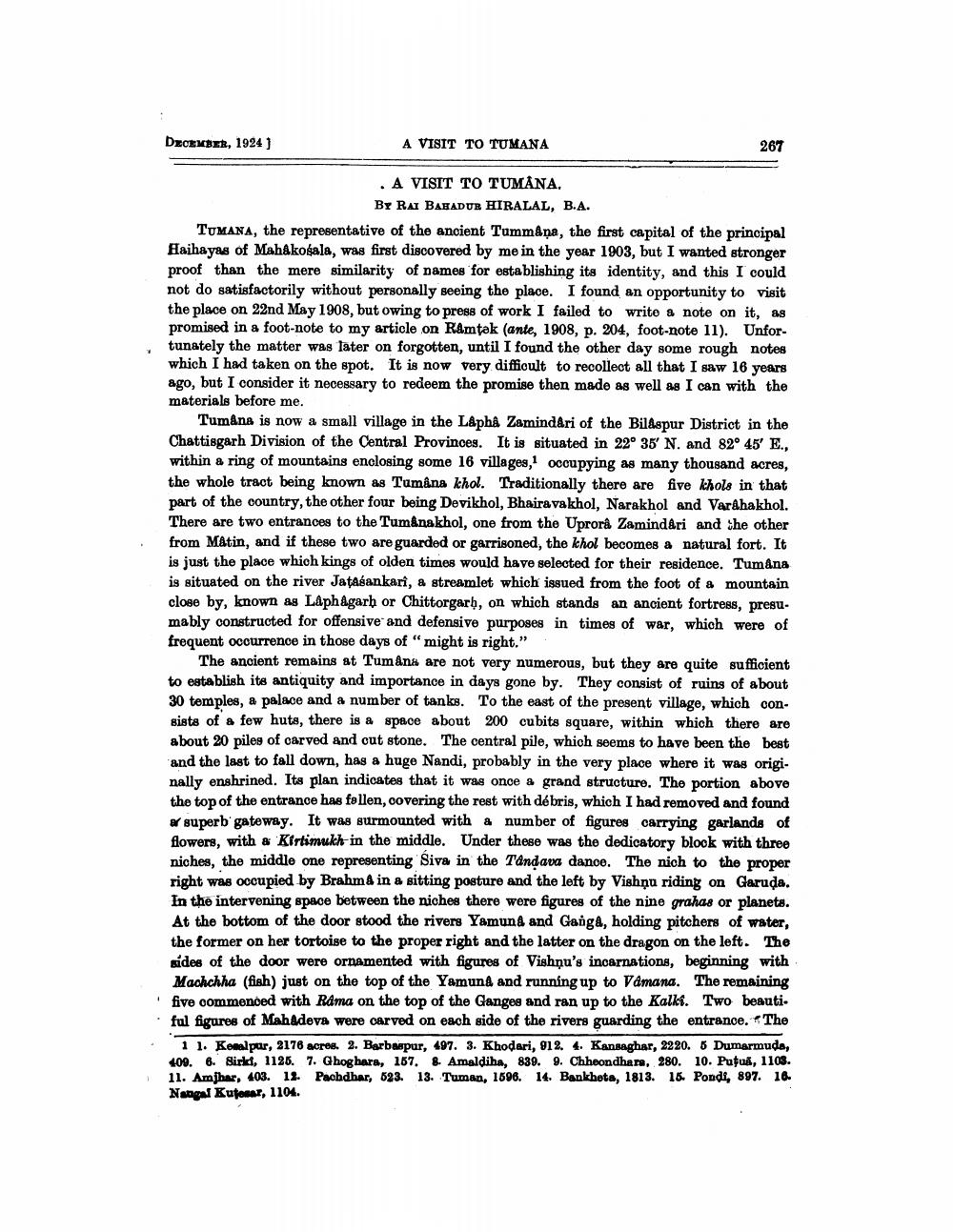________________
DXORMBER, 1924 1
A VISIT TO TUMANA
267
. A VISIT TO TUMANA.
BY RAI BAHADUR HIRALAL, B.A. TUMANA, the representative of the ancient Tummana, the first capital of the principal Haihayas of Mahakosala, was first discovered by me in the year 1903, but I wanted stronger proof than the mere similarity of names for establishing its identity, and this I could not do satisfactorily without personally seeing the place. I found an opportunity to visit the place on 22nd May 1908, but owing to press of work I failed to write a note on it, as promised in a foot-note to my article on Ramtak (ante, 1908, p. 204, foot-note 11). Unfortunately the matter was later on forgotten, until I found the other day some rough notes which I had taken on the spot. It is now very difficult to recollect all that I saw 16 years ago, but I consider it necessary to redeem the promise then made as well as I can with the materials before me.
TumAna is now a small village in the L&pha ZamindAri of the Bilaspur District in the Chattisgarh Division of the Central Provinces. It is situated in 22° 35' N. and 82° 45' E., within a ring of mountains enclosing some 16 villages, occupying as many thousand acres, the whole tract being known as Tumana khol. Traditionally there are five khols in that part of the country, the other four being Devikhol, Bhairavakhol, Narakhol and VarAhakhol. There are two entrances to the Tumánakhol, one from the Uprorê Zamindari and the other from Matin, and if these two are guarded or garrisoned, the khol becomes a natural fort. It is just the place which kings of olden times would have selected for their residence. Tumana is situated on the river Jatasankari, a streamlet which issued from the foot of a mountain close by, known as Laph Agarh or Chittorgarh, on which stands an ancient fortress, presumably constructed for offensive and defensive purposes in times of war, which were of frequent occurrence in those days of "might is right."
The ancient remains at Tumans are not very numerous, but they are quite sufficient to establish its antiquity and importance in days gone by. They consist of ruins of about 30 temples, a palace and a number of tanks. To the east of the present village, which consists of a few huts, there is a space about 200 cubits square, within which there are about 20 piles of carved and out stone. The central pile, which seems to have been the best and the last to fall down, has a huge Nandi, probably in the very place where it was originally enshrined. Its plan indicates that it was once a grand structure. The portion above the top of the entrance has fallen, covering the rest with débris, which I had removed and found
superb gateway. It was surmounted with a number of figures carrying garlands of flowers, with a Kirtimukh in the middle. Under these was the dedicatory blook with three niches, the middle one representing Siva in the Tandava dance. The nich to the proper right was occupied by Brahmin sitting posture and the left by Vishnu riding on Garuda. In the intervening space between the niches there were figures of the nine grahas or planets. At the bottom of the door stood the rivers Yamund and Gange, holding pitchers of water, the former on her tortoise to the proper right and the latter on the dragon on the left. The sides of the door were ornamented with figures of Vishnu's incarnations, beginning with Machchha (fish) just on the top of the Yamund and running up to Vamana. The remaining
five commenced with Rama on the top of the Ganges and ran up to the Kalki. Two beauti. . ful figures of Mahadeva were carved on each side of the rivers guarding the entrance. The
11. Kemalpar, 2176 acres. 2. Barbapur, 497. 3. Khodari, 012. 4. Kansaghar, 2220. 8 Dumarmude, 409. 6. Sirke, 1126. 7. Ghoghara, 157. & Amaldiha, 839. 9. Chheondhara, 280. 10. Putu, 1108. 11. Amjhar, 403. 12. Paodhar, 623. 13. Tuman, 1596. 14. Bankhota, 1813. 16. Pondi, 897. 16. Nangal Kufuar, 1104.




